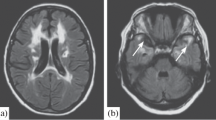Abstract
Cerebral autosomal dominant arteriopathy with subcortical infarcts and leukoencephalopathy (CADASIL) is primarily characterized by migraine, stroke, mood disturbances, and cognitive decline. Ataxia has seldom been reported as a presenting symptom. Here, we review reports of CADASIL presenting as ataxia and compare these to the first pathologically confirmed case of CADASIL presenting with progressive ataxia. A 50-year-old woman presented with progressive truncal ataxia. Brain magnetic resonance imaging (MRI) revealed white matter hyperintensities in the bilateral anterior temporal lobes, external capsules, and periventricular areas, but not the cerebellum. Electron microscopy of skin biopsy material revealed multiple granular osmiophilic materials. Genetic testing confirmed a c.4552C > A mutation in exon 25 of the NOTCH3 gene. CADASIL is a rare cause of progressive ataxia, and only four cases of CADASIL presenting with ataxia have been reported in the literature. We also discuss the possible pathophysiology of cerebellar ataxia associated with CADASIL.

Similar content being viewed by others
References
Vedeler C, Bindoff L. A family with atypical CADASIL. J Neurol. 2011;258(10):1888–9. https://doi.org/10.1007/s00415-011-6023-z.
Sari US, Kisabay A, Batum M, Tarhan S, Dogan N, Coskunoglu A, et al. CADASIL with atypical clinical symptoms, magnetic resonance imaging, and novel mutations: two case reports and a review of the literature. J Mol Neurosci. 2019;68(4):529–38. https://doi.org/10.1007/s12031-019-01313-z.
Chabriat H, Vahedi K, Iba-Zizen MT, Joutel A, Nibbio A, Nagy TG, et al. Clinical spectrum of CADASIL: a study of 7 families. Cerebral autosomal dominant arteriopathy with subcortical infarcts and leukoencephalopathy. Lancet. 1995;346(8980):934–9. https://doi.org/10.1016/s0140-6736(95)91557-5.
Jing XZ, Jiang W, Gan L, Zhu WA, Dong M, Yu P, et al. CADASIL with spinal cord involvement: a case report and literature review. J Neurol. 2019;266(9):2330–3. https://doi.org/10.1007/s00415-019-09436-4.
Bersano A, Bedini G, Markus HS, Vitali P, Colli-Tibaldi E, Taroni F, et al. The role of clinical and neuroimaging features in the diagnosis of CADASIL. J Neurol. 2018;265(12):2934–43. https://doi.org/10.1007/s00415-018-9072-8.
Motolese F, Rossi M, Gangemi E, Bersano A, Scelzo E, Di Lazzaro V, et al. CADASIL as multiple sclerosis mimic: a 48-year-old man with severe leukoencephalopathy and spinal cord involvement. Mult Scler Relat Disord. 2020;41:102014. https://doi.org/10.1016/j.msard.2020.102014.
Miranda M, Dichgans M, Slachevsky A, Urbina F, Mena I, Venegas P, et al. CADASIL presenting with a movement disorder: a clinical study of a Chilean kindred. Mov Disord. 2006;21(7):1008–12. https://doi.org/10.1002/mds.20879.
Moreton FC, Cullen B, Delles C, Santosh C, Gonzalez RL, Dani K, et al. Vasoreactivity in CADASIL: comparison to structural MRI and neuropsychology. J Cereb Blood Flow Metab. 2018;38(6):1085–95. https://doi.org/10.1177/0271678X17710375.
Tatsch K, Koch W, Linke R, Poepperl G, Peters N, Holtmannspoetter M, et al. Cortical hypometabolism and crossed cerebellar diaschisis suggest subcortically induced disconnection in CADASIL: an 18F-FDG PET study. J Nucl Med. 2003;44(6):862–9.
Su J, Huang Q, Ren S, Xie F, Zhai Y, Guan Y, et al. Altered brain glucose metabolism assessed by (18)F-FDG PET imaging is associated with the cognitive impairment of CADASIL. Neuroscience. 2019;417:35–44. https://doi.org/10.1016/j.neuroscience.2019.07.048.
Huang L, Yang Q, Zhang L, Chen X, Huang Q, Wang H. Acetazolamide improves cerebral hemodynamics in CADASIL. J Neurol Sci. 2010;292(1–2):77–80. https://doi.org/10.1016/j.jns.2010.01.023.
Liem MK, Lesnik Oberstein SA, Haan J, Boom R, Ferrari MD, Buchem MA, et al. Cerebrovascular reactivity is a main determinant of white matter hyperintensity progression in CADASIL. AJNR Am J Neuroradiol. 2009;30(6):1244–7. https://doi.org/10.3174/ajnr.A1533.
Auer DP, Putz B, Gossl C, Elbel G, Gasser T, Dichgans M. Differential lesion patterns in CADASIL and sporadic subcortical arteriosclerotic encephalopathy: MR imaging study with statistical parametric group comparison. Radiology. 2001;218(2):443–51. https://doi.org/10.1148/radiology.218.2.r01fe24443.
Liem MK, Lesnik Oberstein SA, Versluis MJ, Maat-Schieman ML, Haan J, Webb AG, et al. 7 T MRI reveals diffuse iron deposition in putamen and caudate nucleus in CADASIL. J Neurol Neurosurg Psychiatry. 2012;83(12):1180–5. https://doi.org/10.1136/jnnp-2012-302545.
Sun C, Wu Y, Ling C, Xie Z, Kong Q, Fang X, et al. Deep gray matter Iron deposition and its relationship to clinical features in cerebral autosomal dominant Arteriopathy with subcortical infarcts and leukoencephalopathy patients: a 7.0-T magnetic resonance imaging study. Stroke. 2020;51(6):1750–7. https://doi.org/10.1161/strokeaha.119.028812.
Pirker W, Katzenschlager R. Gait disorders in adults and the elderly: a clinical guide. Wien Klin Wochenschr. 2017;129(3–4):81–95. https://doi.org/10.1007/s00508-016-1096-4.
Thompson PD. Frontal lobe ataxia. Handb Clin Neurol. 2012;103:619–22. https://doi.org/10.1016/b978-0-444-51892-7.00044-9.
Holtbernd F, Eidelberg D. Functional brain networks in movement disorders: recent advances. Curr Opin Neurol. 2012;25(4):392–401. https://doi.org/10.1097/WCO.0b013e328355aa94.
Fouillade C, Chabriat H, Riant F, Mine M, Arnoud M, Magy L, et al. Activating NOTCH3 mutation in a patient with small-vessel-disease of the brain. Hum Mutat. 2008;29(3):452. https://doi.org/10.1002/humu.9527.
Funding
This research was partly supported by the Basic Science Research Program through the National Research Foundation of Korea funded by the Ministry of Education (No. NRF-2017R1C1B5018378 (J.H.Y), NRF-2018M3A9E8023859 (J.H.Y).
Author information
Authors and Affiliations
Contributions
JHY contributed to the study conception and design. Material preparation and data collection were performed by DGP, JHM, SHS, and YBS. The first draft of manuscript was written by DGP and JHY, and all authors commented on previous versions of the manuscript. All authors read and approved the final manuscript.
Corresponding author
Ethics declarations
Conflict of Interest
The authors declare that they have no conflict of interest.
Ethical Approval
All procedures performed in studies involving human participants were in accordance with the ethical standards of the institutional and/or national research committee and with the 1964 Helsinki declaration and its later amendments or comparable ethical standards.
Additional information
Publisher’s Note
Springer Nature remains neutral with regard to jurisdictional claims in published maps and institutional affiliations.
Electronic supplementary material
ESM 1
The patient finds it difficult to rise from a chair and to walk even with assistance. Limb ataxia is evident in finger-to-nose, heel-to-shin, and rapid alternating movement tests. The patient provided written informed consent for publication of this video. (MP4 1995 kb)
Rights and permissions
About this article
Cite this article
Park, D.G., Min, J.H., Sohn, S.h. et al. Ataxia Associated with CADASIL: a Pathology-Confirmed Case Report and Literature Review. Cerebellum 19, 907–910 (2020). https://doi.org/10.1007/s12311-020-01173-z
Published:
Issue Date:
DOI: https://doi.org/10.1007/s12311-020-01173-z




